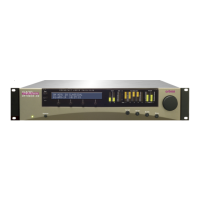OPTIMOD-AM DIGITAL OPERATION
3-9
The equalizer in the digital radio processing chain can be used freely to color the
audio as necessary to create a signature sound for the station. Meanwhile, the five-
band compressor should be operated with a slow release time so that it smoothes
out spectral inconsistencies between sources while not significantly affecting pro-
gram density — added density would unnecessarily stress the very low bit rate codec
used in the HD AM system.
Although the HD AM receivers crossfade between analog and digital when the digi-
tal drops out, it is impossible to make this crossfade subtle because the audio band-
width typically changes from 15 kHz to 3 kHz and the soundfield collapses to mono.
The best that one can do is to approximately match the loudness of the HD and ana-
log chains. Fortunately, the receiver applies 5 dB more gain to the digital signal than
to the analog signal, so even highly processed analog signals can achieve approxi-
mate loudness parity with lightly processed digital signals.
The 9400’s presets have been adjusted to achieve reasonable loudness parity when
the audio bandwidth of the analog decoding section of the radio is approximately
2.5 kHz. If the bandwidth is wider, then analog loudness will increase. There is no
perfect solution to this problem; the best compromise tunes the processing for an
average (2.5 kHz audio bandwidth) radio.
In the HD processing channel, Orban’s PreCode™ technology minimizes codec arti-
facts. To exploit this technology fully, do not set up the 9400’s HD processing chan-
nel for very bright sound (with large amounts of high frequency energy) because
this is likely to exacerbate artifacts. Some appropriate presets include J
AZZ, SMOOTH
JAZZ, GOLD, ROCK SOFT, and the CLASSICAL presets. Avoid presets like CRISP and EDGE;
these are very bright-sounding presets and are more appropriate for uncompressed
channels or compressed channels with relatively high bitrates (64 kbps or higher for
the aacPlus V2 codec used in Orban’s OPTICODEC-PC, for example).
The 9400’s HD processing channel has several controls whose settings determine
brightness. To minimize brightness:
Use little or no high frequency boost in the HD equalization section.
Set the HD
BAND 4>5 COUPLING to 100%.
Set the HD
B5 THRESH to match the codec. Adjust the threshold until you find
a good compromise between presence and high frequency codec artifacts. We
find the range from –6.0 to +6.0 dB to be useful. For the HDC codec at 36
kbps, try –6.0 to 0.0 dB, depending on format.
Use a moderate Band 5 attack time. 25 ms works well.
If necessary, lower the HD
B4 THRESH.
In addition, it is unwise to use stereo enhancement with low bitrate codecs. At low
bitrates, codecs use various parametric techniques for encoding the spatial attrib-
utes of the sound field. Stereo enhancement can unnecessarily stress this encoding
process.

